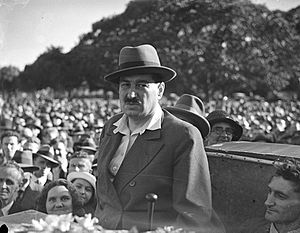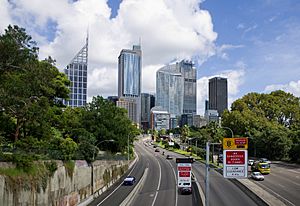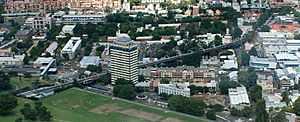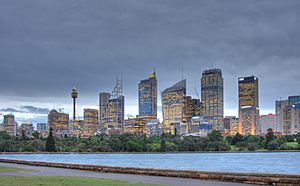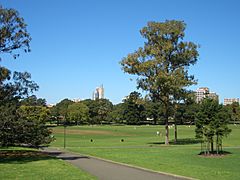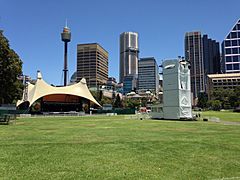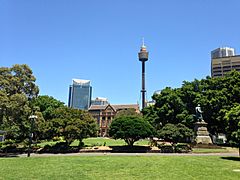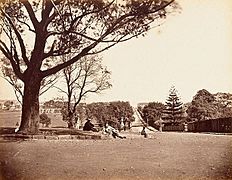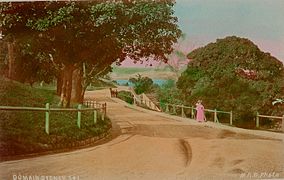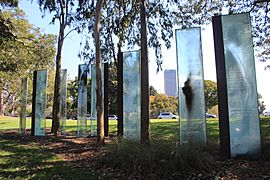The Domain, Sydney facts for kids
Quick facts for kids The Domain |
|
|---|---|
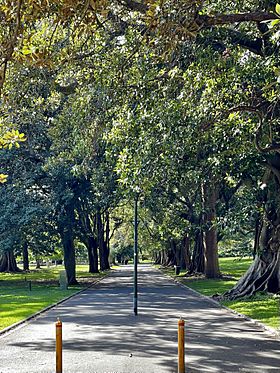
Paths of The Domain, Sydney
|
|
| Lua error in Module:Location_map at line 420: attempt to index field 'wikibase' (a nil value). | |
| Type | Natural area; sports fields |
| Location | Woolloomooloo |
| Nearest city | Sydney |
| Area | 34 hectares (84 acres) |
| Created | c. 1830s |
| Operated by | Royal Botanic Gardens Trust |
| Status | Open all year |
| Public transit access | |
| Official name | Royal Botanic Gardens and Domain; Tarpeian Way; Botanical Gardens |
| Type | State heritage (landscape) |
| Designated | 2 April 1999 |
| Reference no. | 1070 |
| Type | Garden Botanic |
| Category | Parks, Gardens and Trees |
| Builders | Charles Fraser; Allan Cunningham; Richard Cunningham; Charles Moore; Joseph Maiden; Carrick Chambers |
The Domain is a large, historic open space in Sydney, New South Wales, Australia. It covers about 34 hectares (that's like 34 football fields!). You can find it on the eastern edge of Sydney's main city area.
The Domain is right next to the famous Royal Botanic Gardens. Both are managed by the Royal Botanic Gardens Trust. People in Sydney use The Domain every day for exercise and relaxing. It's also a popular spot for big outdoor concerts, events, and large public gatherings. The Domain and the Royal Botanic Gardens were added to the New South Wales State Heritage Register on April 2, 1999, which means they are important historical sites.
History of The Domain
How The Domain Started
The story of The Domain began in July 1788, just six months after the First Fleet arrived in Sydney. Governor Arthur Phillip set up a small farm in a nearby cove, which was called Farm Cove.
Further up from Farm Cove, Governor Phillip set aside a special open area just for himself. He called it the 'Phillip Domain'. This area stretched from the Tank Stream to Woolloomooloo Bay. The farm was meant for growing grain, but the soil wasn't very good, so the farm moved to Parramatta. For the next 20 years, the Farm Cove area was rented out for private farming.
Even though a ditch was dug in 1792 to mark its boundary, people slowly started to build on parts of The Domain. Governor Bligh tried to get this land back, which was one of the many reasons for a big disagreement called the 'Rum Rebellion' in 1808.
When Governor Macquarie arrived in 1810, he built stone walls around the Government House garden and the Government Domain. This separated them from Hyde Park. The Botanic Gardens are considered to have started when Mrs Macquarie's Road was finished on June 13, 1816. By 1817, The Domain was fully enclosed with roads and gates to control horse traffic.
In the 1830s, The Domain was cleared of trees and opened to the public. People could now stroll and have picnics there. The part of The Domain west of Macquarie Street was later sold. This money helped pay for new buildings like the Government House and Circular Quay. Over time, more government buildings were built on the southwestern part of The Domain. These included the Hyde Park Barracks, the Sydney Mint, Sydney Hospital, Parliament House, the State Library of New South Wales, and the Land Registry Office. The Art Gallery of New South Wales was built on the eastern side.
Cricket Matches at The Domain
Cricket games, which had been played in Hyde Park since the early 1800s, moved to The Domain in the 1850s. The New South Wales team played against the Victoria team in their first inter-colonial match in Melbourne in 1856. New South Wales won! The next match was played at The Domain from January 14-16, 1857, and New South Wales won again.
For the next 14 years, The Domain was used for cricket. However, it wasn't a great cricket ground. It was rough, uneven, and open. Cricketers often had to deal with the public, who believed it was a public park. Plus, cattle still grazed there, so cow pats sometimes had to be removed before a game could start! Even though cricket games were big events, often attended by the Governor, the ground wasn't enclosed. This meant no one could charge an entrance fee to watch.
These problems led to a public meeting on December 13, 1859, where the New South Wales Cricket Association was formed. They started looking for a better cricket ground. This search was still going on when the first English team toured Australia in 1862. Since there was no other place, they played a NSW team at The Domain.
A solution came when the Albert Ground opened in Redfern in 1864. It had good facilities, but it was expensive for the NSWCA to use. So, they kept using The Domain until the early 1870s. In total, six important cricket matches were played at The Domain between 1856 and 1869.
| Season | Teams | Date | Result | Ref |
|---|---|---|---|---|
| 1856–57 | New South Wales v Victoria | 14–16 January 1857 | New South Wales won by 65 runs | |
| 1858–59 | New South Wales v Victoria | 20–22 January 1859 | Victoria won by 2 wickets | |
| 1860–61 | New South Wales v Victoria | 14–16 February 1861 | Victoria won by 21 runs | |
| 1862–63 | New South Wales v Victoria | 5–7 February 1863 | New South Wales won by 84 runs | |
| 1866–67 | New South Wales v Victoria | 26–27 December 1866 | New South Wales won by an innings and 13 runs | |
| 1868–69 | New South Wales v Victoria | 4–6 March 1869 | Victoria won by 78 runs |
Later Uses and Changes
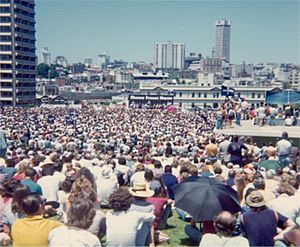
After cricket, The Domain was used for military events and ceremonies. It also became a famous place for public speaking and political meetings. From 1860, The Domain was opened at night for people to walk around, making it a valuable place for fun on summer evenings. It became known as the Park where the Gates Never Close.
Sydney's growth put a lot of pressure on The Domain. A big change was the building of the Garden Palace for the Sydney International Exhibition (1879). This huge building burned down in 1882, and only its gates and some statues remain. The land where the Garden Palace stood later became part of the Royal Botanic Gardens.
Many important political rallies and meetings have happened in The Domain. These include Palm Sunday rallies, May Day demonstrations, and protests against war. On February 17, 1935, a Czech journalist named Egon Kisch spoke to 18,000 people in The Domain. He warned about the dangers of Hitler's Nazi government and the risk of war. His visit caused a lot of debate in Australia.
During the intense election campaign after the Australian constitutional crisis of 1975, the Australian Labor Party and its leader, Gough Whitlam (who had recently been removed as Prime Minister), held their policy launch in The Domain on November 24, 1975. A massive crowd of 30,000 people attended, filling The Domain and spilling over.
In more recent years, major transport projects have changed The Domain. A big one was the building of the Cahill Expressway in 1952. This project widened roads around The Domain into expressways. The expressway now separates The Domain from the Royal Botanic Gardens.
In 1959, the Domain Parking Station was built underground, beneath The Domain. You can get to it using a long moving walkway from College Street. This walkway is 207 meters long and has a painted mural showing Aboriginal and local scenes. It's likely the longest continuous moving walkway in the Southern Hemisphere! Then, in the 1970s, a railway tunnel for the Eastern Suburbs Line was built under the southern part of The Domain. In 1992, the Sydney Harbour Tunnel was built, with its southern section also running under The Domain.
Today, The Domain is still a popular place for Sydney residents and visitors. They come to relax and enjoy amazing views of the city and Sydney Harbour. On weekdays, you'll see joggers on its roads and people playing soccer or touch football on the grass.
Exploring The Domain's Features
The Domain starts in the south near St Mary's Cathedral and ends in the north at Mrs Macquarie's Point, which is a headland on Sydney Harbour. Roads and the Cahill Expressway divide The Domain into different sections. The Royal Botanic Gardens are to the northwest.
Phillip Precinct: Open Spaces for Fun
The part of The Domain west of Art Gallery Road and south of the Cahill Expressway is called "Phillip Precinct." It's a large open grassy area with groups of trees. It's named after Governor Arthur Phillip. This area has walkways and a restaurant called "Pavilion on the Park." Many public buildings, like Sydney Hospital and Parliament House, back onto this park.
This part of the park is popular for city workers to relax, exercise, and play sports. It often hosts meetings and events. In summer, a temporary stage is set up here for open-air concerts and other events. The northern side of this area has an open section of the Cahill Expressway, which is sunken below the park's ground level.
Speakers Corner is in the northeastern part of Phillip Precinct, near the Art Gallery of New South Wales. It was officially set up in 1878. Historically, it was an important place where anyone could show up and talk about any topic they wanted. People with different views might argue back! This spot has been key for free speech in Sydney. Even though it's not used as much now, its role is protected by law. A steel platform with names of famous speakers still stands there.
Crescent Precinct: Art and Parking
The part of The Domain east of Art Gallery Road and south of the Cahill Expressway is called the "Crescent Precinct." It slopes down sharply towards Woolloomooloo. This area is dominated by the Art Gallery of New South Wales, which has a classic front facing Art Gallery Road and a modern part built into the eastern slope.
Near the southern end of Art Gallery Road is the main entrance to The Domain, with a historic gatehouse. Playing fields are in the southeast of this area, built above the Domain Parking Station.
The Domain Parking Station is a large underground car park with 1,130 spaces. It's used by visitors to the Art Gallery, people attending events at The Domain, and city workers. It also has a moving walkway that takes people from the car park to the top of Hyde Park. This walkway is 207 meters long and has a painted mural along its entire length. It's thought to be the longest continuous moving walkway in the Southern Hemisphere!
Mrs Macquarie's Point: Iconic Views
North of the Art Gallery, Art Gallery Road crosses over the Cahill Expressway. A narrow strip of parkland connects the Crescent Precinct to the "Yurong Precinct" at Mrs Macquarie's Point. Here, The Domain is a thin green strip with the Royal Botanic Gardens to the west and Woolloomooloo Bay to the east.
Further north, The Domain covers the entire peninsula of Mrs Macquarie's Point. Farm Cove is to the west and Woolloomooloo Bay is to the east. This spot offers the famous view of the Sydney Opera House and the Sydney Harbour Bridge. It's a very popular place for tourists and photographers.
Mrs Macquarie's Chair was carved out of the rock for Governor Lachlan Macquarie's wife. She would sit there to watch ships pass by. Above the chair, there's an inscription marking the completion of Mrs Macquarie's Road on June 13, 1816.
The Fleet Steps connect Farm Cove to Mrs Macquarie Road. They are named after the Great White Fleet of the US Navy, which visited Sydney in 1908. This is also the spot where Queen Elizabeth II first stepped onto Australian soil. A special plaque marks this event. This site is often used for big events with amazing views of the Opera House and Harbour Bridge.
The Andrew "Boy" Charlton Pool is an outdoor swimming pool next to Woolloomooloo Bay. Veil of Trees is a sculpture made of glass panels. It was put up in 1999 between the pool and the "Lion Gate Lodge" of the Royal Botanic Gardens.
Tarpeian Precinct: Harbour Views
This area is cut off from the rest of The Domain by the Cahill Expressway. It's a narrow strip of parkland along the eastern side of Macquarie Street and the western edge of the Royal Botanic Gardens. It rises towards the north to an elevated area near Bennelong Point. From here, you can look down at the forecourt of the Sydney Opera House.
This area is called the "Tarpeian Precinct." It's named because its rocky cliff looks a bit like the Tarpeian Rock in ancient Rome. This small green space has large trees and offers views of parts of Circular Quay, the Harbour Bridge, and the Opera House. Government House is right next to this area. The views from the Tarpeian Precinct were changed a bit when a building called "the Toaster" was built.
Events at The Domain
Many big events are held every year at The Domain, especially during the summer holidays in December and January. Many of these are part of the Sydney Festival. These large events happen in the Phillip precinct, where a temporary stage is set up every November for the festival season.
Some of the most popular and long-running annual events that are now Sydney 'traditions' include:
- Carols in the Domain: A nationally televised Christmas carols event held on the last Saturday before Christmas.
- Sydney Festival trio: Symphony in The Domain (with the Sydney Symphony Orchestra), Jazz in the Domain, and Opera in The Domain (with Opera Australia). These are held on consecutive Saturday evenings in January.
- Tropfest: A short film festival that was held in The Domain every February from 1999 until 2013. It grew so big that it moved to the larger Centennial Park.
An 'Open Air Cinema' operates in the summer months near the Fleet Steps. The movie screen sits on poles in the water at Farm Cove. The audience sits along the shore, facing the Opera House and Harbour Bridge. The screen lies flat on the water so people can enjoy the views before the movie starts. Then, it lifts up for the film!
Since 2012, the Fleet Steps have also been used for annual outdoor opera shows called Handa Opera on Sydney Harbour. These happen in March and April.
Images for kids
-
Crowd at ALP policy launch in the Domain on 24 November 1975



